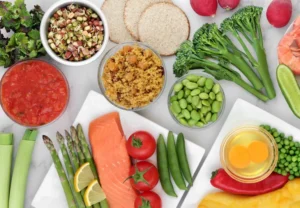
Low-Glycemic Index Meal Ideas for Weight Loss: A Comprehensive Guide

In the quest for effective weight loss, it is crucial to pay attention to the types of food we consume. One approach gaining popularity is the incorporation of low-glycemic index (GI) meals into our diets.
Table of Contents
Introduction
The glycemic index measures how quickly carbohydrates in food raise blood sugar levels. Low-GI foods provide a steady release of energy, promote satiety, and help maintain stable blood sugar levels. In this article, we will explore a variety of low-GI meal ideas that can aid in weight loss and provide a sustainable and nutritious approach to healthy eating.

Understanding the Glycemic Index

The glycemic index (GI) is a scale that ranks carbohydrates based on how quickly they raise blood sugar levels. Foods with a high GI are rapidly digested and absorbed, causing a sharp spike in blood sugar levels. On the other hand, foods with a low GI are digested and absorbed more slowly, resulting in a gradual and steady increase in blood sugar levels.
The GI classification is as follows:
Low GI: 55 or less
Medium GI: 56-69
High GI: 70 or above
Several factors influence the GI of a particular food, including the type of carbohydrate, cooking method, processing, and the presence of fiber and fat. Foods high in refined carbohydrates like white bread, white rice, and sugary snacks tend to have a high GI, while whole grains, legumes, fruits, and vegetables generally have a lower GI.
Understanding the glycemic index is essential for weight loss because low-GI foods provide a gradual release of energy, preventing sudden spikes and crashes in blood sugar levels. This steady supply of energy helps to regulate appetite, reduce cravings, and promote a sense of fullness.
Benefits of Low-Glycemic Index Meals for Weight Loss

Incorporating low-GI meals into a weight loss plan offers several benefits:
- Steady blood sugar levels and sustained energy: Low-GI foods promote stable blood sugar levels, preventing energy highs and lows throughout the day. This helps to maintain consistent energy levels and minimize cravings for unhealthy snacks.
- Enhanced satiety and reduced cravings: Low-GI foods are typically rich in fiber and take longer to digest, keeping you feeling fuller for longer. This can help control appetite and reduce the likelihood of overeating or succumbing to unhealthy food cravings.
- Improved insulin sensitivity and diabetes management: Consuming low-GI meals can enhance insulin sensitivity, which is important for individuals with diabetes or those at risk of developing the condition. Low-GI diets have been shown to improve blood sugar control and reduce the need for insulin in individuals with type 2 diabetes.
- Reduced risk of heart disease and improved cardiovascular health: Low-GI diets, which emphasize whole grains, fruits, vegetables, and lean proteins, are associated with a reduced risk of heart disease. They help maintain healthy cholesterol and triglyceride levels, lower blood pressure, and improve overall cardiovascular health.
- Potential for increased weight loss and weight management: Low-GI meals may facilitate weight loss and weight management by promoting a balanced, nutrient-dense diet. By stabilizing blood sugar levels, reducing hunger pangs, and promoting satiety, low-GI meals can support healthy eating habits and long-term weight maintenance.
It’s important to note that while low-GI meals offer benefits for weight loss, they should be incorporated as part of an overall balanced and calorie-controlled diet.
Low-Glycemic Index Meal Planning

Effective low-GI meal planning involves several key strategies to ensure balanced nutrition and variety:
- Understanding portion sizes and balancing macronutrients: While focusing on the GI of individual foods is important, it’s also crucial to pay attention to portion sizes and the overall macronutrient balance in meals. Incorporate appropriate portions of protein, healthy fats, and fiber-rich carbohydrates to create satisfying and well-rounded low-GI meals.
- Incorporating a variety of low-GI foods in meals: Aim for a diverse range of low-GI foods to ensure a wide array of nutrients and flavors. Include whole grains like quinoa, brown rice, and whole wheat bread, as well as legumes, vegetables, and fruits with a low GI. This variety will help prevent dietary monotony and promote adherence to the meal plan.
- Planning for snacks and desserts with low-GI alternatives: Snacks and desserts can be challenging when following a low-GI meal plan. Opt for snacks such as raw vegetables with hummus, Greek yogurt with fresh berries, or a small handful of nuts. For desserts, choose options like fresh fruit, low-sugar Greek yogurt, or a small piece of dark chocolate.
- Meal prepping and convenient low-GI options: Planning and prepping meals in advance can be a game-changer for staying on track with a low-GI diet. Prepare larger batches of low-GI meals and portion them into individual servings for quick and convenient meals throughout the week. Additionally, consider using time-saving options like frozen low-GI vegetables or canned legumes to add ease to meal preparation.
By implementing these strategies, you can create a well-balanced low-GI meal plan that supports your weight loss goals while providing adequate nutrition and enjoyment.
Disclaimer: The information provided in this article is for educational purposes only and should not be considered as a substitute for medical advice. Consult a healthcare professional before implementing any home remedies or making significant changes to your lifestyle.
Low-Glycemic Index Meal Ideas

Low-Glycemic Index Breakfast Ideas
Breakfast is often considered the most important meal of the day, and incorporating low-GI options can set the tone for balanced eating throughout the day. Here are some delicious low-GI breakfast ideas:
- Whole grain oatmeal with berries and nuts: Start your day with a bowl of oatmeal made from whole grains, such as steel-cut oats or rolled oats. Top it with a handful of fresh berries like blueberries or raspberries, along with a sprinkle of chopped nuts like almonds or walnuts. This combination provides fiber, antioxidants, and healthy fats to keep you satisfied and energized.
- Greek yogurt with sliced fruits and chia seeds: Choose plain Greek yogurt, which is low in added sugars and high in protein. Add a variety of sliced fruits like strawberries, kiwi, or peaches for natural sweetness and additional nutrients. Sprinkle some chia seeds for an omega-3 fatty acid boost and added fiber.
- Vegetable omelet with whole grain toast: Whip up an omelet with egg whites or whole eggs and load it with an assortment of colorful vegetables such as spinach, bell peppers, mushrooms, and onions. Serve it with a slice of whole grain toast for complex carbohydrates and fiber.
- High-fiber smoothies with spinach and avocado: Blend together a nutritious smoothie using low-GI ingredients. Start with a base of unsweetened almond milk or Greek yogurt, then add a handful of spinach, half an avocado for healthy fats, and a scoop of protein powder. For natural sweetness, include a small amount of low-GI fruits like berries or half a banana.
These breakfast ideas provide a balance of carbohydrates, protein, and healthy fats, along with fiber-rich ingredients that support digestion and help maintain stable blood sugar levels.
Low-Glycemic Index Lunch Ideas
Lunchtime offers an opportunity to refuel and recharge for the rest of the day. Here are some satisfying low-GI lunch ideas:
- Quinoa and roasted vegetable salad: Cook a batch of quinoa, a protein-rich grain with a low GI, and let it cool. Toss it with a variety of roasted vegetables such as sweet potatoes, bell peppers, zucchini, and cherry tomatoes. Add some fresh herbs, a drizzle of olive oil, and a squeeze of lemon juice for flavor.
- Grilled chicken breast with mixed greens and vinaigrette: Grill a chicken breast and serve it on a bed of mixed greens. Make homemade vinaigrette using extra virgin olive oil, balsamic vinegar, Dijon mustard, and a touch of honey or maple syrup for a low-GI dressing. Add some cherry tomatoes, cucumber slices, and avocado for extra freshness and nutrients.
- Lentil soup with whole grain bread: Lentils are a great source of plant-based protein and have a low GI. Prepare a hearty lentil soup using vegetable broth, chopped vegetables like carrots, celery, and onions, and aromatic spices. Pair it with a slice of whole grain bread for a well-rounded and filling lunch.
- Brown rice and vegetable stir-fry: Cook some brown rice, a nutrient-rich whole grain, and set it aside. Stir-fry a mix of colorful vegetables like broccoli, bell peppers, snap peas, and carrots in a small amount of olive oil. Add some lean protein such as tofu, shrimp, or chicken if desired. Season with low-sodium soy sauce or a homemade stir-fry sauce.
These lunch ideas offer a combination of fiber, protein, and a range of colorful vegetables, ensuring a satisfying and nourishing midday meal.
Low-Glycemic Index Dinner Ideas
Dinner is an opportunity to unwind and enjoy a satisfying meal. Here are some low-GI dinner ideas that are both delicious and weight-loss-friendly:
- Baked salmon with roasted sweet potatoes and steamed broccoli: Season a fresh salmon fillet with herbs, lemon juice, and a drizzle of olive oil. Bake it in the oven until cooked through. Serve it with roasted sweet potatoes, which have a lower GI compared to regular potatoes, and steamed broccoli for a nutritious and well-balanced dinner.
- Turkey meatballs with zucchini noodles and tomato sauce: Prepare turkey meatballs using lean ground turkey, whole wheat breadcrumbs, and herbs. Bake or pan-fry them until cooked. Use a spiralizer or julienne peeler to make zucchini noodles as a low-GI alternative to pasta. Top the zucchini noodles with a flavorful tomato sauce made from scratch or choose a low-sugar store-bought option.
- Grilled tofu with quinoa and sautéed spinach: Marinate tofu slices in a mixture of low-sodium soy sauce, garlic, and ginger. Grill or pan-fry until golden. Serve it with cooked quinoa, which provides protein and fiber, and a side of sautéed spinach for added nutrients.
- Beef stir-fry with brown rice and mixed vegetables: Slice lean beef into thin strips and stir-fry it with a medley of colorful vegetables like bell peppers, broccoli, snap peas, and mushrooms. Use a low-sodium stir-fry sauce for flavor and serve it with cooked brown rice for a satisfying and balanced meal.
These dinner ideas incorporate lean proteins, whole grains, and plenty of vegetables to provide essential nutrients and support weight loss goals.
Low-Glycemic Index Snack and Dessert Ideas
Snacks and desserts can be enjoyable while still being low-GI. Here are some ideas to satisfy your cravings:
- Apple slices with almond butter: Slice a crisp apple and enjoy it with a tablespoon of almond butter. The combination of fiber from the apple and healthy fats from the almond butter will keep you satiated and provide a balance of flavors.
- Raw vegetables with hummus: Cut up a variety of colorful vegetables like carrots, bell peppers, celery, and cherry tomatoes. Dip them in a portion-controlled serving of hummus, which adds protein and healthy fats to the snack.
- Greek yogurt with fresh berries: Choose plain Greek yogurt, which is lower in sugar and higher in protein compared to flavored varieties. Top it with a handful of fresh berries like strawberries, blueberries, or raspberries for natural sweetness and antioxidants.
- Dark chocolate-covered almonds: Indulge in a small portion of dark chocolate-covered almonds. Dark chocolate with a high cocoa content is lower in sugar and provides antioxidants, while almonds offer healthy fats and fiber.
These snack and dessert ideas offer a balance of nutrients, portion control, and a touch of sweetness without causing drastic blood sugar spikes.
Tips for Incorporating Low-Glycemic Index Meals into Your Lifestyle

To successfully incorporate low-GI meals into your lifestyle, consider the following tips:
- Read food labels and choose wisely: Check the nutritional labels of packaged foods to identify the carbohydrate content and choose options with lower GI values. Look for whole grains, fiber-rich ingredients, and minimal added sugars.
- Experiment with different cooking methods and flavors: Explore various cooking techniques such as roasting, grilling, steaming, or sautéing to bring out the natural flavors of low-GI foods and make your meals more enjoyable. Experiment with herbs, spices, and healthy sauces to add flavor without relying on high-GI ingredients.
- Plan your meals and snacks in advance: Take some time to plan your meals and snacks for the week. This will help you make conscious choices and ensure that you have the necessary ingredients on hand. Consider meal prepping to save time and make it easier to stick to your low-GI meal plan.
- Focus on whole, unprocessed foods: Opt for whole, unprocessed foods as they are generally lower in GI and provide more nutrients. Incorporate plenty of fruits, vegetables, whole grains, lean proteins, and healthy fats into your meals.
- Be mindful of portion sizes: While low-GI foods are beneficial, portion control is still important for weight loss. Be mindful of your portion sizes and listen to your body’s hunger and fullness cues. It’s easy to overeat even low-GI foods if portions are not controlled.
- Stay hydrated: Adequate hydration is important for overall health and can also help control appetite. Drink plenty of water throughout the day to stay hydrated and avoid mistaking thirst for hunger.
- Seek professional guidance if needed: If you have specific dietary requirements, medical conditions, or if you’re unsure about designing a low-GI meal plan, consult with a registered dietitian or nutritionist. They can provide personalized guidance and support to help you achieve your weight loss goals.
FAQs (Frequently Asked Questions)
Q1. What is the glycemic index (GI) and why is it important for weight loss?
A1. The glycemic index (GI) is a scale that ranks carbohydrates based on how quickly they raise blood sugar levels. It’s important for weight loss because low-GI foods provide a gradual release of energy, preventing spikes and crashes in blood sugar levels, which can help control appetite and reduce cravings.
Q2. What are the benefits of incorporating low-GI meals into a weight loss plan?
A2. Low-GI meals offer several benefits, including steady energy levels, enhanced satiety, improved insulin sensitivity, reduced risk of heart disease, and potential for increased weight loss and weight management.
Q3. Can low-GI meals help with diabetes management?
A3. Yes, low-GI meals can help improve blood sugar control and insulin sensitivity, making them beneficial for individuals with diabetes or those at risk of developing the condition.
Q4. Are low-GI meals suitable for heart health?
A4. Yes, low-GI diets, which emphasize whole grains, fruits, vegetables, and lean proteins, are associated with a reduced risk of heart disease. They can help maintain healthy cholesterol levels, lower blood pressure, and improve overall cardiovascular health.
Q5. Is it necessary to follow a specific diet plan to incorporate low-GI meals for weight loss?
A5. While there are specific low-GI diet plans, low-GI meals can be incorporated into a balanced and calorie-controlled diet to support weight loss effectively.
Q6. What strategies can I use for effective low-GI meal planning?
A6. Effective low-GI meal planning involves understanding portion sizes, incorporating a variety of low-GI foods, planning snacks and desserts with low-GI alternatives, and using convenient options like frozen vegetables or canned legumes.
Q7. Can you provide some low-GI breakfast ideas for weight loss?
A7. Sure, here are some low-GI breakfast ideas: whole grain oatmeal with berries and nuts, Greek yogurt with sliced fruits and chia seeds, vegetable omelet with whole grain toast, and high-fiber smoothies with spinach and avocado.
Q8. What are some low-GI lunch ideas that are both satisfying and weight-loss-friendly?
A8. Some low-GI lunch ideas include quinoa and roasted vegetable salad, grilled chicken breast with mixed greens and vinaigrette, lentil soup with whole grain bread, and brown rice and vegetable stir-fry.
Q9. Can you suggest low-GI dinner ideas that are delicious and suitable for weight loss?
A9. Certainly! Low-GI dinner ideas include baked salmon with roasted sweet potatoes and steamed broccoli, turkey meatballs with zucchini noodles and tomato sauce, grilled tofu with quinoa and sautéed spinach, and beef stir-fry with brown rice and mixed vegetables.
Q10. Are there any low-GI snack and dessert ideas to satisfy cravings while still supporting weight loss?
A10. Yes, you can enjoy low-GI snacks and desserts like apple slices with almond butter, raw vegetables with hummus, Greek yogurt with fresh berries, and dark chocolate-covered almonds in moderation to satisfy cravings without causing blood sugar spikes.
Conclusion
Incorporating low-glycemic index meals into your weight loss plan can be a smart and effective strategy. By choosing foods with a low GI, you can regulate blood sugar levels, control cravings, and promote satiety. The benefits of low-GI meals extend beyond weight loss and can contribute to better overall health, including improved blood sugar control, heart health, and increased insulin sensitivity.
By understanding the glycemic index, planning meals and snacks ahead of time, and focusing on whole, unprocessed foods, you can create a sustainable and enjoyable low-GI eating pattern. Remember to be mindful of portion sizes, experiment with different flavors and cooking methods, and seek professional guidance when needed.
With commitment and consistency, low-glycemic index meal ideas can become an integral part of your weight loss journey, helping you achieve your goals while nourishing your body with balanced and nutritious foods. Embrace the benefits of low-GI eating and enjoy the wide array of delicious options available to support your weight loss and overall well-being.
Remember, weight loss is a personal journey, and it’s important to listen to your body’s needs and adjust your approach accordingly. Stay motivated, stay focused, and embrace the power of low-glycemic index meals for successful and sustainable weight loss.






